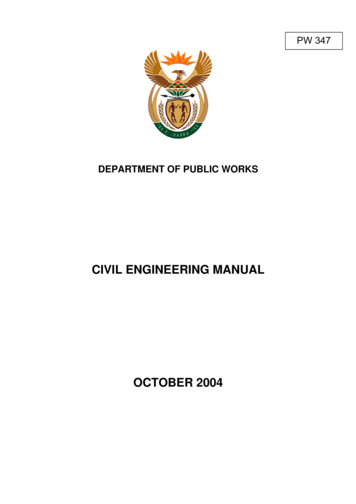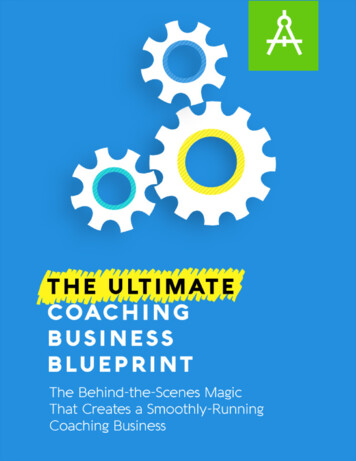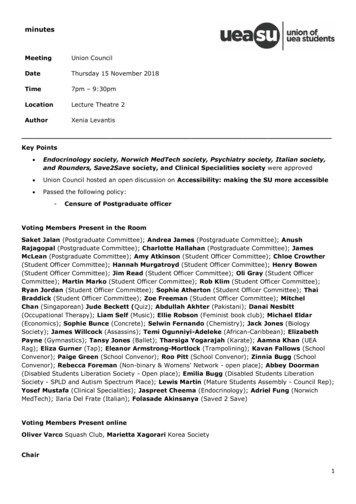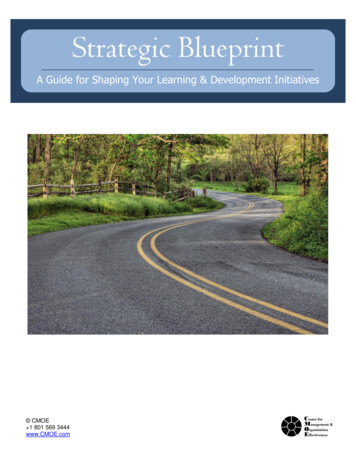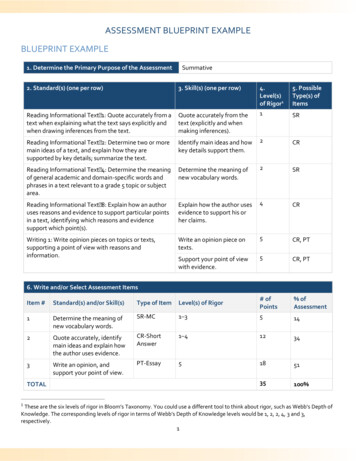
Transcription
BLUEPRINTBLUEPRINTTHE ANNUALINDUSTRY FORECASTTHE ANNUALINDUSTRY FORECASTby Lucy Bernholzby Lucy Bernholz2022PHILANTHROPY ANDDIGITAL CIVIL SOCIETY:PHILANTHROPY ANDDIGITAL CIVIL SOCIETY:
2021 Lucy Bernholz. Attribution and share alike.ISBN 978-1-7341875-2-6lucybernholz.comFor more information, contact bernholz@stanford.edu.Copies available for free download ints.AcknowledgmentsThis edition of the Blueprint was informed by dedicated conversations withthe digital civil society fellows 2020 cohort. Several foundation presidentsand scholars participated in dedicated conversation about freedom andphilanthropy. I would like to give a special thanks to Anne Focke (editor),Lorenzo Manuali (copy editor), and my Digital Civil Society Lab colleaguesRebecca Lapena and Toussaint Nothias. The layout is by Mahyar.Kazempour.Ben Crothers did the fantastic illustrations. I am responsible for all du/digital-civil-society
CONTENTS2WHAT IS THIS MONOGRAPH?3INTRODUCTION7SECTION 1: COLLECTIVE ARCHITECTUREPHILANTHROPY PROVOCATEURSDIGITAL CIVIL SOCIETY IN ACTION14SECTION 2: TIMEWHAT IS YOUR TIME FRAME FOR CHANGE?OVERTON WINDOWSTHE STATUS QUO AND THE SPEED OF TIMEJUMPING THROUGH THE PORTAL?24SECTION 3: SPACEWHERE IS DIGITAL CIVIL SOCIETY?THE CONTEXT IN WHICH CIVIL SOCIETY LIVES AND WORKSNEW THREATS TO THE SPACE OF DIGITAL CIVIL SOCIETYIMAGINING BETTER DIGITAL SPACES35SECTION 4: MOTIONACTIONS THAT ONLY CIVIL SOCIETY CAN TAKEPROVIDING ALTERNATIVES TO CURRENT DIGITAL STRUCTURES41CODA: WHY NOW MATTERSAN HISTORIAN’S VIEW OF NOW: A “SECOND GILDED AGE”?WHY THIS MOMENT MATTERS44BUZZWORD WATCH46PREDICTIONS FOR 202248SCORECARD: RENOVATIONS TO 2021 PREDICTIONS50WHERE TO GO FOR MORE53ENDNOTES
WHAT IS THIS MONOGRAPH?Philanthropy and Digital Civil Society: Blueprint 2022 is the 13th annual industry forecastabout the ways we use private resources for public benefit in the digital age. Each year, Iuse the Blueprint to provide an overview of the current landscape, point to big ideas thatwill matter in the coming year, and direct your attention to sources of future promise.WHY IS IT CALLED A BLUEPRINT?I use the metaphor of a blueprint to describe the forecast because blueprints are guidesfor things yet to come and storage devices for decisions already made. My father is anarchitect. I grew up surrounded by scale models of buildings, playing in unfinishedfoundations and trying to not get hurt by exposed rebar. I eavesdropped on discussionswith contractors, planning agencies, homeowners, and draftsmen1—all of whom bringdifferent skills and interpretations to creating, reading, and using blueprints. Creatinga useful blueprint requires drawing ideas from many people, using a common grammarso that work can get done, and expecting multiple interpretations of any final product. Iintend my Blueprints to speak to everyone involved in using private resources for publicbenefit as well as to help people see their individual and institutional roles within thedynamics of the larger collective project of creating civil society. I hope you will use it as astarting point for debate and as input for your own planning. Please join the discussion onTwitter at #blueprint22.WHO WROTE THIS DOCUMENT?I’m Lucy Bernholz, and I’m a philanthropy wonk. I am senior research scholar anddirector of the Digital Civil Society Lab, which is part of Stanford University’s Center onPhilanthropy and Civil Society (PACS). HuffPost calls me a “philanthropy game changer,”Fast Company magazine named my blog Philanthropy2173 “Best in Class,” and I’ve twicebeen named to The Nonprofit Times’ annual list of the 50 most influential people. I earneda BA in history from Yale University and an MA and PhD from Stanford University. OnTwitter, I’m known as @p2173, and my website is www.lucybernholz.com. The DigitalCivil Society Lab curates, creates, and shares free resources related to data governance atwww.digitalimpact.io.WHERE CAN I GET MORE INFORMATION?In addition to my blog and website, information about Stanford’s Digital Civil SocietyLab is at www.pacscenter.stanford.edu. Previous Blueprints can be downloaded ints. If you are just joining the Blueprintseries with this edition, welcome. If you’ve been reading since 2010, thank you. Feel free togo back in time by reviewing previous editions, several of which include organizationalworksheets. The worksheets are free online at https://digitalimpact.io/tools/.PHILANTHROPY AND DIGITAL CIVIL SOCIETY: BLUEPRINT 20222
INTRODUCTION“Don’t forget to envision a world that values humanity.”Ytasha L. Womack2I’m trained as an historian. I’ve learned thisheard saying, “I don’t know what day it is.”means I have a different sense of time thanI was unanchored from past rhythms andsome other people. In my normal routine,was spending my time in video meetingsI think about the moment I’m in by firstacross time zones. I adapted to theremembering or wondering about whatroutinelessness of days that bled together—came before. Then, my mind flashes forwardpunctuated by brief moments of relief andto wonder if and how future historiansrelentless fear of the next fresh horror. Thiswill think about the time I’m in from theirwas all intermingled with persistent grief,perch in the years to come. So, at any givenwhich punctuates time in its own ways. I’vemoment, I’m thinking about the past andhad lots of time to think about time—howhow the future will think of the past that is,we experience it and how we try to alter,in fact, the present I’m in. This is also whatstructure, or soften into those experiences.I think Octavia E. Butler might have meantwhen, in 2000, she noted about herself:In last year’s Blueprint, I borrowed author“I don’t predict the future. All I do is lookArundhati Roy’s image of the pandemicaround at the problems we are neglectingas a portal. She encouraged us to think ofnow and give them about 30 years to growour times as a threshold, an opportunity tointo full-fledged disasters.”3determine what to take through with us tothe future and what to leave behind.4 PublicAt any given moment I’mthinking about the past and howthe future will think of the pastthat is, in fact, the present.I don’t know if I became an historian becauseof the way that I experience time or iftraining as an historian did this to me. I justknow that it is.discourse has been full of attempts to makesense of the times we’re in. Most peopleon the planet are still facing the terror of adeadly, contagious virus with little to protectthem but distance and face masks. A smallpercentage of humanity has been vaccinated,and too many of the vaccinated act as if theirvirological protection is a calling card toreturn to something called normal. (Such a“normal” must exist on the “before” side ofthe pandemic, so why would you want to goImagine living through the last two yearsthere?) In fact, in her image of a portal, Roy(five years, 50 years) in this manner. Forsaid, “Nothing could be worse than a returnmost of 2020 and 2021, people could beto normality.” Scientists who focus on thePHILANTHROPY AND DIGITAL CIVIL SOCIETY: BLUEPRINT 20223
mutating nature of viruses and those whoI like this picture because without evenstudy the rapidly accelerating pace and scopethinking about the math you can see aof climate-damaged physical transformationsignificant shift, a redirection, a new path. Theurge us toward understanding the permanentargument to consider is this: People and ourstate of change we’re in.systems brought on global warming, and itScientists who focus on the mutating natureof viruses and those who study the rapidlyaccelerating pace and scope of climatedamage urge us toward understanding thepermanent state of change we’re in.is now clear that the structures and practiceswhich brought us to this point—whetherthey be economical, political, or social—willneither redress nor solve the harms done.We’ve reached the point on that graph (markedby two red dots) where doing the same thingwon’t take us in the expected direction,but rather will catapult us somewhere elseentirely. It’s not merely a matter of passingWriters, artists, and others pay a lot ofthrough a portal—we need to “leap” throughattention to the constancy of change. Theirthe moment, making major shifts.work might be focused directly on climatechange or on the braided implicationsof a changing planetary ecosystem withhumanity’s existing practices, biases, laws,and institutions. A favored word amongsuch writers is discontinuity—a term thatin mathematics means the point at whicha function shifts or stops. 5 In physics, itdescribes “an interruption in the normalstructure of a thing.” Here’s a modifiedWe and our systems brought onglobal warming, and it is nowclear that the structures andpractices which brought us tothis point will neither redressnor solve the harms done.graph of a mathematical equation with a“jump discontinuity.”That’s a big challenge. Not only does it callinto question all that we as individuals,communities,and institutionsdo, but it alsoshould castdoubt on ourusual tacticsfor thinking aboutand planning for thefuture. Theories of change,strategic plans, linear processes,even “agility” and “adaptability” don’tseem up to the task of hopping across thatbreak. The discontinuities brought on byglobal warming led to the descending blueline above—that’s what a mathematicaldiscontinuity looks like. If we choose insteadto act courageously, informed by science andPHILANTHROPY AND DIGITAL CIVIL SOCIETY: BLUEPRINT 20224
with an eye toward positive futures for all,and connect dots; it’s harder to connectwe can use the discontinuity point to leapdots when you’re experiencing them daily.into positive futures. We are at this point ofWe now have reason to imagine that manydiscontinuity—only big changes will lead todesirable “impossibilities” are possible and topositive futures. Ytasha L. Womack, whoseask what we can do to make them reality.epigraph begins this Introduction, remindsus that when we do jump, we can’t leave ourhumanity behind.Only big changes will leadto positive futures.Digging into the use of the termdiscontinuity, I learned something aboutI’ve written this publication for 12common narratives. We’re all familiar withconsecutive years—this is the 13th edition.the term disruption, a phrase and claim thatIn the spirit of doing something different,entrepreneurs, investors, and the mediathis seemed like a good time to structurehave hyped with such persistence that noit in a new way. When I started thecorner of society—least of all nonprofitsBlueprint, there were few others writingand philanthropic foundations—hasabout the intersections of philanthropy,been spared. It turns out that the originalsocial economies, technology, and publictext that started this obsession drewpolicy. Now, there are robust alternativefrom previous work that used the phraseframeworks (see Edgar Villanueva’s workdiscontinuity instead.6 Still, there’s oneabout decolonizing wealth, Carolinenotable difference I see between disruptionShenaz Hossein’s work about communityand discontinuity as they’ve played out inbanking, and Sara Horowitz’s work aboutcommon parlance. Disruption is somethingMutualism) and solid scholarship (see Reich,well-resourced, valorized individuals andMorey, Ming Francis).7 Additionally, harshcompanies do unto others; discontinuity iscritiques of philanthropy are appearingdone unto all of us.and receiving pushback, though theimpact of the critiques themselves is lessI recommend taking today’s discontinuityimpressive. In the U.S., there’s even a smallseriously. This historical moment echoesboom in public writing that loudly andprevious political and social ones—theconsistently questions extreme wealth andyears after World War Two, the fall of thebig philanthropy, from Tim Schwab at TheSoviet Union, or the years leading up to andNation to a new publication called Puckimmediately following the American Civil(which, as an historian, makes me smile,War. While we focus on politics and socialsince its namesake and predecessor is achoices—that is, things humans design—wehumor magazine from the 1870s that is coremust factor into today’s calculations theto American social history).environmental forces that our previouschoices have unleashed, which are movingThis edition of the Blueprint is organizedat a pace and scale that surpass anythingaround three principles of physics—time,we’ve experienced. Historians look backspace, and motion. Why? We (and here IPHILANTHROPY AND DIGITAL CIVIL SOCIETY: BLUEPRINT 20225
mean all humans) are experiencing an eraFor the most part, I will use time, space,of extraordinary uncertainty and potential.and motion metaphorically—specifically asPhysicists ask big questions, often aboutprompts to think about urgency, community,the tiniest particles of matter. Big questionsand action. I hope not to offend any quantumabout systems paired with the examinationphysicists, or anyone else, by not diggingof our own individual practices are usefulinto the newest, most awe-inspiring researchfor thinking about philanthropy and digitalabout these concepts. Rather, I simplycivil society.want to try to capture the wonder of thatknowledge—the sense of “Wait a minute,To help me with these questions and to carrythings don’t work the way we think they do.forward the larger project of the Blueprint,Perhaps there are other ways.” Sara Hernden,I’m including voices beyond my own in thisa professor at Olin College and author ofedition. For several years, I’ve been tryingone of my favorite books from the last year8,different ways to do this, both to globalizewrote about how urban planners, who designmy thinking and to engage with people whophysical spaces, can use time as a designexperience and understand the world inelement. Braiding time and space together,ways that are different from the way I do. Ior urgency and community—this kind ofhope to pass off the Blueprint, or the idea ofthinking is what I’m thinking about.9it, to others—to take myself out of the way.I’m trying several ways to do this, includingThe principles of time, space, and motiona new section called Collective Architecture.each have their own section in this Blueprint,but they’re also useful outside these sections.You’ll find additional references to themthroughout the document.PHILANTHROPY AND DIGITAL CIVIL SOCIETY: BLUEPRINT 20226
SECTION 1COLLECTIVEARCHITECTURE“We have to move from survivalist tactics, aimed at protectingindividual lives in a disaster, to survival strategies that could helpour entire species make it through a mass extinction.”Annalee Newitz10Everything I know, I learned from otherI am inspired by Portals to beautiful futures,people. This section is based on twoled by the Guild of Future Architects anddifferent sets of conversations I’ve had in thefunded by the Omidyar Network. Shapingpast year. The first, Philanthropy Provocateurs,the future is about more than just leavingholds my reflections on a conversation heldcertain assumptions and structures behind;in September 2021 that included severalit is very much about making explicit ourfoundation presidents, advisors to them,dreams and hopes for a better world.scholars, and critics. Participants includedDrs. Carmen Rojas, Glen Galaich, MeganMing Francis, Maribel Morey, EricaKohl-Arenas, and Tyra Mariani.The second, Digital Civil Society in Action,draws from individual and group discussionswith current and former fellows of theDigital Civil Society Lab; all are people whocome from civil society and are focused onintersections of technology, justice, inclusion,and democracy. Where permission wasgranted, I attribute ideas to those who voicedthem. For others, participating in theseShaping the future is about more than justleaving certain assumptions and structuresbehind; it is about making explicit ourdreams and hopes for a better world.What follows are insights based on what I’velearned from each set of conversations. Theyare organized in line with the broader themesof time, space, and motion, which I alsodiscuss in more detail later in the Blueprint.discussions was predicated on not beingPHILANTHROPY PROVOCATEURSnamed. I call this section Collective ArchitectureI have worked in or around institutionalto riff further on the Blueprint theme—peoplephilanthropy since 1991. For much of thatworking together see different opportunitiestime, there has been a trope among centerand highlight different challenges.and center-left foundations that right11PHILANTHROPY AND DIGITAL CIVIL SOCIETY: BLUEPRINT 20227
wing and conservative foundations getenfranchisement are gaining traction.things done. They fund for the long term,Each of these actions is an element of amake general operating grants, stay theworld that is free for more people thancourse, and, perhaps most importantly,ever before in this nation’s history. Theywork together toward a shared vision ofare pieces of a shared vision. Progress onfree markets and individual liberties. Theeach of them is being made on a small scale.appointment of three conservative justicesReparations are being paid in some placesto the U.S. Supreme Court between 2017 andand being discussed in legislatures. Some2020 was seen by many as the culminationof the philanthropic funding unleashedof a 40-year philanthropic strategy.12 Howafter the murder of George Floyd has beenthat philanthropic strategy entwines withused to buy back land stolen from Nativeovertly political funding is a critical part ofAmericans and others. Police abolition offersany such analysis. Alongside this trope isan important real-time example of how whatone about philanthropy on the left which iswas once a radical thought is now framingthat it shares none of those characteristics.discussions, even if most of the philanthropicIt is problem-focused, not vision-driven;engagement around it is limited and centersit’s short-term and programmatic; therearound small-scale police reforms (seeare constellations of visions, but nosection on Overton Windows, page 17). Thissingle organizing force; it’s populated byis the historic process of moderation andprofessionals who are more liberal (maybecapture that is part of the history of socialprogressive) than the boards or donors whomovements and philanthropy told so wellmade the money and make final decisions.by scholars Megan Ming Francis, MaribelThere are truths in all of this, proven by theMorey, and Erica Kohl-Arenas.1513exceptions to these statements as much asanything else.These ideas and the progress made towardthem are examples of possible “impossibles.”But my conversations with the “philanthropySome may be able to see them most clearlyprovocateurs” prove that there’s also moreby reflecting on the ferocity of opposition toto any such story. And we must think aboutthem. The U.S has been structured to pursuethis in the context of our time—a timea true multiracial democracy only since thewhen inequality in wealth, income, health,passage of the Voting Rights Act in 1965, andeducation, and fissures in social cohesion areefforts to prevent it from taking full effectat all-time extremes.14have intensified with every additional stepforward. This push-counterpush throughTIMEWe are in a moment right now in whichthe contours of a shared, progressive,collective vision of society are visible.In the U.S., longstanding movements forreparations, land back, abolition, and fullWe are in a moment right now in whichthe contours of a shared, progressive,collective vision are visible.time can also be seen when you look closelyat legal advances in the expansion of votingrights (1965), which were followed by effortsto reshape jurisprudence in pro-corporateways (e.g., The Powell Memo of 1971,credited with sparking the creation ofconservative think tanks, such as Heritage,Manhattan, and AEI). A more recentexample is the election of the nation’s firstBlack president countered by an increasedfocus on gerrymandering and control ofstate legislatures (which set voting rules).16PHILANTHROPY AND DIGITAL CIVIL SOCIETY: BLUEPRINT 20228
It is also the story of contemporary events,for our current institutional, legal, andsuch as growing electoral participation byinformation landscapes. PhilanthropicBlack people and people of color counteredfoundations are now established partsby efforts to make voting more difficult andof those landscapes. Many forces beingshift state-level control of elections fromfelt today have been developing since thenonpartisan offices to legislatures.1960s, including the shifting boundariesbetween political and charitable activitySPACEand the rules about financial disclosures.Time and space—urgency and community—played an outsized role in shaping publicentangle in the progress of multiracial,discourse, financing political campaigns,equitable participation, and the intensity ofand funding efforts to limit legal protest,the reactions to them contributes to feelingsexpand protected speech, suppress voting,in the U.S. that there is no common ground,and influence judicial appointments. Asthat extreme polarization rules, and that theartist Jenny Holzer once noted, “[We] livecountry may break into pieces (or has alreadythe surprise results of old plans.”During the same time, large fortunes havedone so). These feelings demonstrate what’sknown by scholars as “affective polarization,”which focuses on the degree to which peoplefeel negatively about political parties otherWhat is it we are funding toward,building to, seeking to create?than their own. It has been growing aroundthe globe over the last several decades,significantly in the United States.17MOTIONThe foundation executives who joinedFor the most part, the mediated publicour discussion noted that foundations ondiscourse about this polarization pitchesthe center/left are not asking, “What doesit as a bad thing. The assumption seemsfreedom look like?” It’s also a tough questionto be that comity is preferable to tension.to answer when posed in a positive way:It’s important to see in this more than theWhat is freedom for, not from? There’s plentysimple observation that comity doesn’t leadof wisdom among those for whom the pursuitto much change for those marginalized andof freedom is their multigenerational history.oppressed by the status quo. The countryYet the visions elicited by asking this secondmay be more than two centuries old, but thequestion might provide more opportunity forlegal frameworks to enfranchise people fromphilanthropic imagination, more points ofevery background (including those who wereleverage or connection, and more urgency forhere before the colonists) have existed onlyparticipation and reconsiderations of power.in my lifetime. This is a new starting groundWhat is it we are funding toward, buildingfor what has been an age-old pursuit—ato, seeking to create?pursuit that clearly is not shared by all.Those in philanthropy and digital civilThis moment in time in the U.S. is oftensociety who are committed to multiracialcompared to the 1960s, or the 1920s, or thedemocracies have an opportunity to help1870s—each of which followed a major war.create something that’s never before existedHistorical comparisons are only so helpful;—not in the U.S. nor, as Danielle Allen ofthey elide the long pursuits of participationHarvard reminds us, anywhere. Articulatingthat come before, and they can’t accountthe true scope of this vision—governmentPHILANTHROPY AND DIGITAL CIVIL SOCIETY: BLUEPRINT 20229
that is truly by, for, and of all the people—with the quip from William Gibson that “theis more than a continuation of old struggles.future is already here, it’s just not evenlyIt’s the pursuit of something that’s neverdistributed.” The same is true of the past.existed. It’s a grand vision.An oft-heard complaint among white peoplein the U.S. is, “Why must Black people (andThe true scope of this vision—governmentthat is truly by, for, and of all the people—is more than a continuation of old struggles.It’s the pursuit of something that’s neverexisted. It’s a grand vision.DIGITAL CIVIL SOCIETY IN ACTIONOver the last five years, I’ve had the goodfortune to work with 40 people from aroundthe globe as part of the Practitioner FellowsProgram that the Digital Civil SocietyLab hosts along with Stanford’s Center onComparative Studies in Race and Ethnicity.The fellows are individually brilliant andcollectively powerful. They’ve drivenchanges in municipal, state, and federal law.They’ve imagined and nurtured bridgesbetween the expertise of marginalizedcommunities and digital rights experts.They’re leading thinkers on collectivecommunity power, designers of profoundsystems of resistance, poets, tinkerers,governance nerds, and policy wonks.TIMEothers) make everything about race?” Whilesimultaneously denying prior racial violence,white Americans would also like to thinkthat racism and terror are things of the past.Black people, Indigenous people, and peopleof color experience racism every day, all thetime. It is not just in the past.An example from another part of the worldmay be helpful. Pádraig Ó Tuama, an Irishpoet, notes that Brexit reanimated theborder between Northern Ireland and theRepublic of Ireland in many ways, includingnew requirements for identification. For thedecision makers in Westminster, the troublesof that border are a thing of the past, yet ÓTuama and his neighbors must now carryevidence of it in their wallets—again. Thosewho hold power can control the narrativeof time. Those targeted by power have theirown sense of time and continuity. The workof fellows such as Owono, Adams, or SamirDoshi (who works with farmworkers) revealsone value of this timeframe difference: Itmakes the consequences of power inequitiesclearer, faster. People being harmed todayknow what harms await the rest of us—inthis way, they are predictors of other people’sBryan Stevenson, founder of the Equalfutures. When I read a tech company’sJustice Initiative and author of Just Mercy,apologies or obfuscation of the “unintendedintroduced many funders to the importanceconsequences” of their products or read theirof proximity. He writes of the need to “getpromises of predictive technologies to comeproximal,” to get close to the people youor when I hear rich politicians debating theare trying to help. Julie Owono, who workscosts of mitigating climate change, I thinkon content moderation in internationalthere’s a better way to see into this future:contexts, and Elizabeth Adams, an AI expertWe can live with and listen to those forwho works on integrating technology intowhom that future is already here. If we wantmunicipal commitments to racial equality,to create futures without harm, we’d be wisehelped me understand that this “nearness” isto heed the advice of those for whom thenot only about relationships and space, butharms are both past and present.it is also about time. You may be familiarPHILANTHROPY AND DIGITAL CIVIL SOCIETY: BLUEPRINT 202210
If we want to create futureswithout harm, we’d be wiseto heed the advice of those forwhom the harms are bothpast and present.SPACEin each other. There are not enough “spaces”like this, I am often told. What did I learnabout digital space from these experiences?It’s not where, but how. What’s important isnot that they happen in digital space, but thatwe must make more such spaces available.The second adjustment to my understandingof space has to do with our tools ofThe fellows have helped me think aboutbelonging. Part of the idea of the fellowshipspace in two different ways. I should noteis to inform change at Stanford. Bringing athat we’ve hosted two cohorts of fellowscohort of racially and geographically diverseduring the pandemic. One group was ablecommunity leaders to campus changesto meet in person for a week in Januarywho speaks at conferences, who gives guest2020 and has otherwise only connectedlectures, who provides opportunities foronline. The other cohort has not yet gatheredstudents, and who faculty and graduatephysically. The fellows come from severalstudents seek out as partners. We’ve beencountries across nine time zones. Theable to do this even through a year ofgeographic scope of their work ranges fromonline-only classes and campus activities.a single municipality to an entire continent.The fellows don’t get the experience ofphysical visits; instead, their affiliations haveThe first adjustment to my understandingbeen marked by email addresses, libraryof space comes from what I have heardaccess, and the ability to sign up for campusfrom the fellows about our gatherings.newsletters, speakers’ series, and lab demos.Our meetings—which happen by videoTheir “space” at Stanford exists throughconference and email listserv—have beenthese tools of access and these markers ofdescribed as “hope sustaining,” “a placebelonging. Providing virtual library accessto bring my whole self,” “the community Ifor 40 people has a marginal cost close tocount on,” and “the only place I can ask thesezero to the institution, and it can be catalyticquestions, bring these concerns, vent myto individuals and organizations.feelings.” How did this group of people makethis space so sacred? I don’t have a singleanswer to this question other than to say thatwe, the hosts, do not really host; we providethe digital gathering point and let the fellowsguide its use. We celebrate each other. Wecome when we’re called, and the fellows callHow might the expense of digitalinfrastructure, subscriptions, or datarepositories that foundations use for theirwork be shared with those they support?Leaving aside for a moment the importantwork of open educational resources andaccess to knowledge, how might otherorganizations—foundations, for example—share the access they have with theirpartners? How might the expense of digitalinfrastructure, subscriptions, or datarepositories that foundations use for theirP
through a portal—we need to “leap” through the moment, making major shifts. That’s a big challenge. Not only does it call into question all that we as individuals, communities, and institutions do, but it also should cast doubt on our usual tactics for thinki

